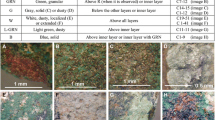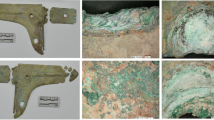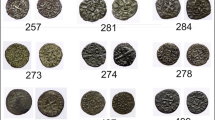Abstract
Three bronze samples created by CNR-ISMN (National Research Council—Institute of Nanostructured Materials) to be similar to Punic and Roman coins found in Tharros (OR, Sardinia, Italy) were studied to identify the corrosion products on their surfaces and to evaluate the reliability of the reproduction process. Micro-Raman spectroscopy was chosen to investigate the corroded surfaces because it is a non-destructive technique, it has high spatial resolution, and it gives the opportunity to discriminate between polymorphs and to correlate colour and chemical composition. A significant amount of green copper hydroxychlorides (Cu2(OH)3Cl) was detected on all the coins. Their discrimination by Raman spectroscopy was challenging because the literature on the topic is currently confusing. Thus, it was necessary to determine the characteristic peaks of atacamite, clinoatacamite, and the recently discovered anatacamite by acquiring Raman spectra of comparable natural mineral samples. Clinoatacamite, with different degrees of order in its structure, was the major component identified on the three coins. The most widespread corrosion product, besides hydroxychlorides, was the red copper oxide cuprite (Cu2O). Other corrosion products of the elements of the alloy (laurionite, plumbonacrite, zinc carbonate) and those resulting from burial in the soil (anatase, calcite, hematite) were also found. This study shows that identification of corrosion products, including discrimination of copper hydroxychlorides, could be accomplished by micro-Raman on valuable objects, for example archaeological findings or works of art, avoiding any damage because of extraction of samples or the use of a destructive analytical technique.





Similar content being viewed by others
References
Bernard MC, Joiret S (2009) Understanding corrosion of ancient metals for the conservation of cultural heritage. Electrochimica Acta: 5199–5205
Bouchard M, Smith DC (2001) Evaluating Raman Microscopy for the non-destructive archaeometry of corroded coins: a powerful technique for conservation studies. Asian Chem Lett 5(3):157–170
Bouchard-Abouchacra M (2001) Evaluation des Capacités de la Microscopie Raman dans la Caractérisation Minéralogique et Physico-chimique de Matériaux Archéologiques: Métaux, Vitraux & Pigments, Paris. Museum National d’Histoire Naturelle
Bouchard M, Smith DC (2003) Catalogue of 45 reference Raman spectra of minerals concerning research in art history or archaeology, especially on corroded metals and coloured glass. Spectrochim Acta Part A 59:2247–2266
Casaletto MP, De Caro T, Ingo GM, Riccucci C (2006) Production of reference “ancient” Cu-based alloys and their accelerated degradation methods. Appl Phys A 83:617–622
Downs R T (2006) The RRUFF Project: an integrated study of the chemistry, crystallography, Raman and infrared spectroscopy of minerals. Program and Abstracts of the 19th General Meeting of the International Mineralogical Association in Kobe, Japan. O03-13
Fleet ME (1975) The crystal structure of paratacamite, Cu2(OH)3Cl. Acta Crystallogr B31:183–187
Frost RL, Martens W, Kloprogge JT, William PA (2002) Raman spectroscopy of the basic copper chloride minerals atacamite and paratacamite – implications for the study of copper, brass and bronze objects of archaeological significance. J Raman Spectrosc 33(10):801–806
Frost RL (2003) Raman spectroscopy of selected copper minerals of significance in corrosion. Spectrochim Acta Part A 59:1195–1204
Hayez V (2005/2006) Use of micro-Raman spectroscopy for the study of the atmospheric corrosion of copper alloys of cultural heritage. PhD These at Vrije Universiteit Brussel, Belgium
Ingo GM, De Caro T, Riccucci C, Angelini E (2006) Large scale investigation of chemical composition, structure and corrosion mechanism of bronze archaeological artefacts from Mediterranean basin. Appl Phys A 83:513–520
Ingo GM, De Caro T, Riccucci C, Khosroff S (2006) Uncommon corrosion phenomena of archaeological bronze alloys. Appl Phys A 83:581–588
Jambor JL, Dutrizac JE, Roberts AC, Grice JD, Szymanski JT (1996) Clinoatacamite, a new polymorph of Cu 2 (OH) 3 Cl, and its relationship to paratacamite and "anarakite". Can Mineral 34:61–72
Lichtenegger HC, Birkedal H, Casa DM, Cross JO, Heald SM, Waite JH, Stucky GD (2005) Distribution and role of trace transition metals in Glycera worm jaws studied with synchrotron microbeam techniques. Chem Mater 17:2927–2931
Lichtenegger HC, Schöberl T, Bartl MH, Waite H, Stucky GD (2002) High abrasion resistance with sparse mineralization: copper biomineral in worm jaws. Science 298:389–392
Liu X, Meng D, Zheng X, Hagihala M, Guo Q (2011) Mid-IR and raman spectral properties of clinoatacamite-structure basic copper chlorides. Adv Mater Res 146–147:1202–1205
Malcherek T, Schlüter J (2010) Anatacamite from La Vendida mine, Sierra Gorda, Atacama desert, Chile: a triclinic polymorph of Cu2(OH)3Cl. N. Jb. Miner Abh 187/3:307–312
Malcherek T, Schlüter J (2009) Structures of the pseudo-trigonal polymorphs of Cu2(OH)3Cl. Acta Crystallogr B65:334–341
Orlić N, Jelovica I, Dobrinić J, Lofrumento C, Salvi PR (2007) Analysis of ancient and medieval specimens using nondestructive spectroscopic techniques. Nucl Instrum Methods Phys Res A 580:739–742
Quaranta M, Sandu I (2008) Micro-stratigraphy of copper-based archaeological objects: description of degradation mechanisms by means of an integrated approach. 9th International Conference on NDT of Art, Jerusalem, Israel, 25–30 May 2008
Wills AS, Henry J-Y (2008) On the crystal and magnetic ordering structures of clinoatacamite, γ-Cu2(OD)3Cl, a proposed valence bond solid. J Phy Condens Matter 20:1–8
Young ML, Casadio F, Marvin J, Chase WT, Dunand DC (2010) An ancient Chinese bronze fragment re-examined after 50 years: contributions from modern and traditional techniques. Archaeometry
Zheng XG, Otabe ES (2004) Antiferromagnetic transition in atacamite Cu2Cl(OH)3. Solid State Commun 130:107–109
Acknowledgments
The authors thank Gabriel Maria Ingo (CNR-ISMN) and Valérie Hayez for kindly providing, respectively, the bronze coins and the clinoatacamite sample and allowing their study.
Author information
Authors and Affiliations
Corresponding author
Additional information
Published in the special issue Analytical Techniques in Art, Archaeology and Conservation Science with guest editor Oliver Hahn.
Rights and permissions
About this article
Cite this article
Bertolotti, G., Bersani, D., Lottici, P.P. et al. Micro-Raman study of copper hydroxychlorides and other corrosion products of bronze samples mimicking archaeological coins. Anal Bioanal Chem 402, 1451–1457 (2012). https://doi.org/10.1007/s00216-011-5268-9
Received:
Revised:
Accepted:
Published:
Issue Date:
DOI: https://doi.org/10.1007/s00216-011-5268-9




